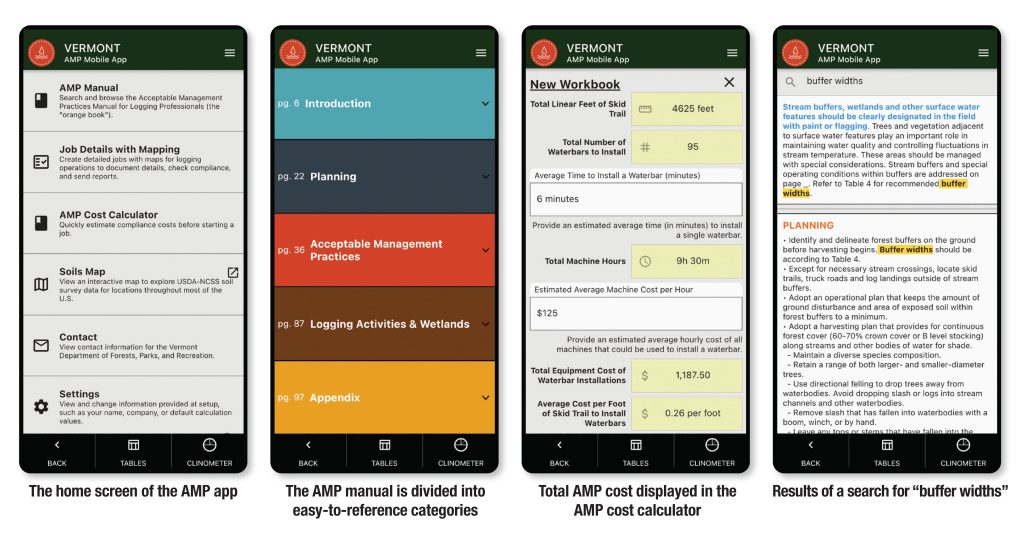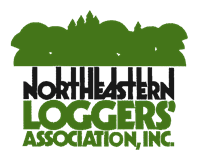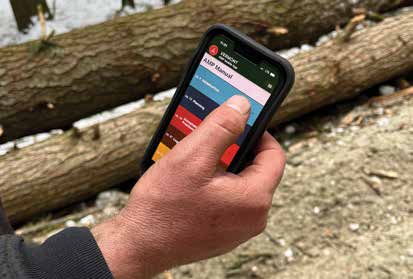Innovation & Technology
NEW TECHNOLOGY IN VERMONT’S FOREST OPERATIONS
By Sam Lincoln
Each state has a set of rules and regulations with accompanying best practices to protect water quality and natural resource features during logging operations. These are typically supported by a hard copy manual, with the printed rules supported by descriptions and illustrations. Manuals are distributed to loggers, foresters, and landowners for users to better understand how to implement best practices. While the traditional manual is filled with useful information, it does not include some of the tools necessary for planning and implementation, and manuals can easily be found under a pile of paperwork on an office desk, or left behind on the dashboard of the truck when the user is in the forest.
When federal funding for clean water initiatives became available to the Vermont Department of Forests, Parks, and Recreation (FPR), the idea to combine and modernize these tools was born – a smartphone and tablet application, or “app” for short. Foresters, landowners, logging contractors, and equipment operators performing different tasks and making decisions in the woods generally have one consistent device with them: a smartphone. FPR’s Watershed Forester, Dave Wilcox, oversees the Acceptable Management Practices for Protecting Water Quality on Logging Jobs in Vermont, or as they’re more commonly referred to in the state, “AMPs.” (In other states, they may be referred to as Best Management Practices, or “BMPs.”) Reflecting on the opportunity to modernize this responsibility, Wilcox said, “We created the app to make the manual easier to access, as well as to provide other tools that would be helpful in implementing the AMPs. Smartphone apps are a natural progression for outreach, and it will allow us to update the manual and tools easily and provides a platform for new technology to be added in the future.”

Examples of the app's features and capabilities include:
- AMP manual and search function: The manual is embedded in the app in an easy-to-reference, section-by-sectionformat. It also has a quick search function to easily access relevant information in the 111-page document. As a logging contractor, I frequently find myself searching for information on “buffers” as I plan trail placement, and the results display every instance where the word “buffer” appears in the manual so I can scroll to what I need.
- Quick reference tables: regularly used parts of the manual were put in their own tabs, including the tables that guide decisions in the woods. Seth Clifford is the Procurement Forester for McNeil Generating Station at Burlington Electric Department, and he works frequently with logging contractors to ensure compliance with chip harvesting permit conditions and the AMPs. Clifford says, “It is incredibly helpful having fingertip access to the structure sizing tables when working with contractors on harvest layout.”
- Soils map: the AMP app links directly to SoilWeb, which allows users to explore a database of soil survey information. Pressing the locator icon in this function will bring the user to a map of their location that displays links to available data, which includes soil type and drainage characteristics, erodibility ratings, and how suitable it may be to operate during different seasons. As summers get unpredictably wetter, and winters have fewer periods of frozen ground, learning to evaluate and understand the soil characteristics on a timber sale will support business owners making more informed decisions about harvest timing, logistics, productivity, and identifying potentially unforeseen costs.
- AMP cost calculator: The costs for machines, labor, culverts, bridges, seed, and mulch, are some of the common items a well-prepared logger needs to tally when preparing for a job. This feature includes data entry fields for these items, and they can easily be adjusted to current costs. Once the user begins entering what they need, the financial cost of compliant water quality protection for the job is displayed at the bottom of the screen. One of the most frustrating things I’ve experienced as a logging contractor is finishing a harvest and realizing I haven’t budgeted enough for all the closeout expenses. This tool will assist logging contractors in the cost analysis on the first day to avoid surprises on the last day.
- Built-in clinometer: The app features a clinometer to measure slope utilizing a device’s camera and internal navigation mechanisms. These tools have been merged with the tables in the AMP rules to create a real-time display of slope-based information for users in the woods. Clifford says, “The clinometer function not only gives you an easy way to determine slope, but with one click on the screen it lets you know required spacing of drainage structures and buffer widths.” The clinometer requires very simple calibration to ensure it is accurately measuring slope and instructions are displayed on the screen
- Use in remote areas: This tool was built with the boots-on-the-ground user in mind and there are tabs for the tables, clinometer, and search function at the bottom of every screen for quick access to frequently used functions. Smartphone apps can be restricted by cell coverage and internet connectivity. The AMP app only requires a connection for downloading jobsite maps (another feature of the app) or retrieving data on SoilWeb. The remaining features work without the need for cell coverage or a Wi-Fi connection after the app is downloaded onto the user’s device.
Wilcox says that FPR is responsible for protecting water quality within the forestry sector, and this technology makes it easier for loggers and foresters to access the information they need to do that. “My goal as the Watershed Forester is to build good relationships with the landowners, loggers, and foresters around the state to foster a clear understanding of those rules, but I also want to provide other tools to help them be successful. One of the best things we can do in Vermont to protect the environment and forest ecosystem is to maintain a healthy and viable forest economy. For me, this begins with taking the mystery out of regulations.”
Regarding updates to the app, Wilcox says, “The goal is to keep it current, and make changes that reflect what’s happening in the real world. It’s much easier to ensure users have the latest information with an app that loads the most recent version every time it's opened. The rules don’t change without a significant public process, but the supporting information, tools, contact information, website links, references, and other information can be updated seamlessly, whereas a printed manual can be outdated within a few months of being printed.”
Mapping technology is continuously improving, and there’s slow but steady progress in cellular connectivity in rural areas. Wilcox envisions updating the app with the capability to calculate drainage areas for stream crossings in the field from any location. This allows users to properly size bridges and culverts, which currently requires very strong cell coverage, or a Wi-Fi connection, to access the website that makes those calculations.
FPR plans to provide training for the app when major features change, and trainings are planned for this field season. The app is free and available on Apple’s App Store or Google Play. Forest professionals are encouraged to download it and start using it regularly in job planning and closeout. For those outside Vermont that would like to take advantage of the features of this app, it will function anywhere, though the mapping feature is not designed to function in other states, and the rules may not be consistent with the AMPs (or BMPs) in your state. Wilcox reports that there have been 240 downloads of the app since it was released in the summer of 2022.
To download the app on your device, search for “Vermont AMP” in the App Store or on Google Play. Or direct the camera on your smartphone or tablet to the QR codes on the right and click on the screen as prompted.
There is a webinar available at this link that goes over each section of the app: https://fpr.vermont.gov/forest/managing-your-woodlands/acceptable-management-practices
For more information, or to provide feedback on how this technology is working for you on the job, please contact Dave Wilcox at [email protected] or at (802) 793-0265.
Sam Lincoln operates Lincoln Farm Timber Harvesting, a mechanized logging operation in central Vermont. He served as Deputy Commissioner of the Vermont Department of Forests, Parks, and Recreation from 2017-2020 and was part of the team that developed the AMP smartphone app.

